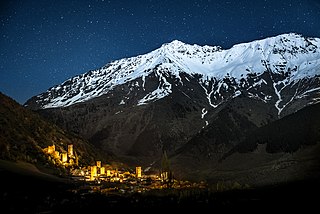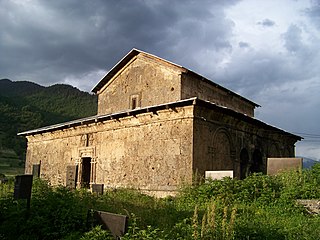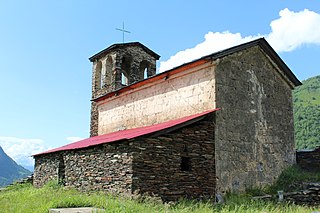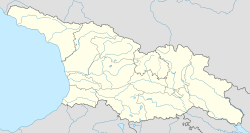
Mestia is a highland townlet (daba) in northwest Georgia, at an elevation of 1,500 metres in the Caucasus Mountains.

Chazhashi is a village in the Mestia Municipality, Samegrelo-Zemo Svaneti, Georgia. It is located in the southern foothills of the Greater Caucasus mountains, in the upper Enguri River valley, at the elevation of 2,160 m above sea level. The village is part of the historical region of Svaneti and center of the Ushguli community. Its medieval fortified structures are inscribed on the registry of Georgia's Immovable Cultural Monuments of National Significance and listed as a UNESCO World Heritage Site as part of the Upper Svaneti entity.

The Iprari church of the Archangels, or Tarngzel as it is locally known, is an 11th-century Georgian Orthodox church at the outskirts of Mestia in Upper Svaneti. Architecturally an unremarkable hall church, Iprari contains a set of frescoes painted by Tevdore in 1096, one of the high points of medieval Georgian monumental art. The church is inscribed on the list of the Immovable Cultural Monuments of National Significance of Georgia.

The Abelia church of the Trinity is a 13th-century Georgian Orthodox church, located in the Tetri Tsqaro Municipality in Georgia's south-central region of Kvemo Kartli. A simple single-nave design, it is situated at the outskirts of the modern-day village of Abeliani, formerly known as Abelia. A reference to the diarchy in Georgia under the Mongol rule in an inscription on the church's southern wall makes it possible to date the construction to the period of 1250–1259. The church is inscribed on the list of the Immovable Cultural Monuments of National Significance of Georgia.

The Gudarekhi monastery is a 13th-century Georgian Orthodox monastery in the south of Georgia. It is located west of the village of Gudarekhi, Tetritsqaro Municipality, in the Kvemo Kartli region. The monastery complex consists of the main hall church, a free-standing bell-tower, and ruins of various structures such as a palace, cells, chapels, wine-cellar, and stables. The church is adorned with medieval stone-carvings and inscriptions. The complex is inscribed on the list of Immovable Cultural Monuments of National Significance.

The Zemo Krikhi church of the Archangel is a 10th–11th-century church in western Georgia, in the highland Ambrolauri Municipality, part of the historical and cultural region of Racha. It is a hall church with a projecting apse, adorned with stone carvings, frescoes, and medieval Georgian inscriptions. The church was almost completely destroyed in the Racha earthquake of 1991 and rebuilt in 2009. It is inscribed on the list of the Immovable Cultural Monuments of National Significance.

The Bieti church of the Mother of God is a ruined Georgian Orthodox church in the Akhaltsikhe Municipality in Georgia's south-central region of Samtskhe-Javakheti. Dated to the latter half of the 14th century, the Bieti church was built in a domed cross-in-square plan. After the dome collapsed in 1930, only the conch of the sanctuary and pastophoria remained standing. After some preparatory cleaning and conservation works, reconstruction was commenced in 2019. The church is inscribed on the list of Georgia's Immovable Cultural Monuments of National Significance. There is another medieval Georgian church known as Bieti situated in what is now the disputed territory of South Ossetia.

The Tsirkoli church of the Mother of God is an 8th–9th-century Georgian Orthodox church near the village of Tsirkoli in the Ksani river valley. It combines the features of domeless and domed church designs and is classified as belonging to the "transitional period" of medieval Georgian architecture. The area, part of the Akhalgori Municipality, came under the control of Russian and South Ossetian forces in the August 2008 Russo-Georgian War. As a result, the Georgian clergy and parish lost access to the church, which is inscribed on Georgia's Immovable Cultural Monuments of National Significance.

The Pavnisi church of Saint George is a Georgian Orthodox church in the Kaspi Municipality in Georgia's east-central region of Shida Kartli. It is a hall church dated to the 9th–10th-century. The church is known for its frescoes dated to the latter half of the 12th century. The church is inscribed on the list of Georgia's Immovable Cultural Monuments of National Significance.

The Savane church of Saint George is an 11th-century Georgian Orthodox church in the western Georgian region of Imereti. A single-nave basilica built in 1046, the church has harmonious proportions, ornamented iconostasis, and exquisite decorative masonry details on the exterior façades. The church is inscribed on the list of Georgia's Immovable Cultural Monuments of National Significance.

The Darkveti church of Saint George is a 10th–11th-century Georgian Orthodox church in the western Georgian region of Imereti. A single-nave basilica with an ambulatory, the church has harmonious proportions and carved masonry ornamentation on the exterior façades. The church is inscribed on the list of Georgia's Immovable Cultural Monuments of National Significance.

The Ekhvevi church of the Mother of God is an 11th-century Georgian Orthodox church in the western Georgian region of Imereti. A single-nave basilica, the church is known for carved masonry ornamentation on the exterior façades. The church is inscribed on the list of Georgia's Immovable Cultural Monuments of National Significance.

The Speti church of the Savior is an 11th-century Georgian Orthodox church in the western Georgian region of Imereti. It is a single-nave hall church, its most recognizable feature being a medieval ornate iconostasis made of alabaster and stucco. The church is inscribed on the list of Georgia's Immovable Cultural Monuments of National Significance.

The Akura church of Saint David is a medieval Georgian Orthodox monastery in the eastern Georgian region of Kakheti. Dated stylistically to the 9th century, it is a three-nave basilica, dedicated to St. David of Gareja, one of the Thirteen Assyrian Fathers. It is inscribed on the list of the Immovable Cultural Monuments of National Significance of Georgia.

The Ienashi church of the Prophet Jonah, also known as the church of Ian, is a medieval Georgian Orthodox church in Mestia, Upper Svaneti. The church was built sometime between the 12th and 14th centuries, but reflects an earlier Georgian practice by having a semi-open aisle—an ambulatory—terminating in an apse to the east of the main nave of the building. The church is inscribed on the list of the Immovable Cultural Monuments of National Significance of Georgia.

The Lashtkhveri church of the Archangel, also known as the church of Taringzel is a medieval Georgian Orthodox church in Mestia, Upper Svaneti. Architecturally an unremarkable hall church, its most recognizable feature is a series of frescoes painted on both internal and external walls, dated to the 14th–15th century. Beyond religious scenes and portraits, the paintings include a rare illustration of episodes from the epic romance on Amiran-Darejaniani. The church is inscribed on the list of the Immovable Cultural Monuments of National Significance of Georgia.

The Matskhvarishi church of the Savior, also known as the church of Matskhvar, is a medieval Georgian Orthodox church in Mestia, Upper Svaneti. It is a simple hall church with extensive 12th-century frescoes. The church is inscribed on the list of the Immovable Cultural Monuments of National Significance of Georgia.

The Kala church of Saints Cyricus and Julitta, locally known as Lagurka (ლაგურკა), is a medieval church in the Mestia Municipality in Georgia's region of Samegrelo-Zemo Svaneti. The area is part of the highland historical and cultural region of Upper Svaneti where Lagurka is regarded as the principal Christian shrine, its designation deriving from the name of Cyricus in the local Svan language. It is a hall church, adorned with frescoes painted by Tevdore in 1111/1112, one of the high points of medieval Georgian monumental art. The church is inscribed on the list of the Immovable Cultural Monuments of National Significance of Georgia.

The Nakipari church of Saint George, locally known as Jgrag (ჯგრაგ), is a medieval church in the Mestia Municipality in Georgia's region of Samegrelo-Zemo Svaneti. The area is part of the highland historical and cultural region of Upper Svaneti. The designation Jgrag derives from the name of Saint George in the local Svan language. It is a hall church, adorned with frescoes painted by Tevdore in 1130. The church is inscribed on the list of the Immovable Cultural Monuments of National Significance of Georgia.

The Chitakhevi church of Saint George is a medieval church in Georgia, located in the country's south-central Borjomi valley in the Samtskhe-Javakheti region. It is popularly known as Mtsvane Monastery, that is, the Green Monastery. Abandoned for more than two hundred years, the monastery was restored to Christian use in 2003. It is a popular site of tourism and pilgrimage. The monastic church and bell-tower are inscribed on the list of the Immovable Cultural Monuments of National Significance of Georgia.

























